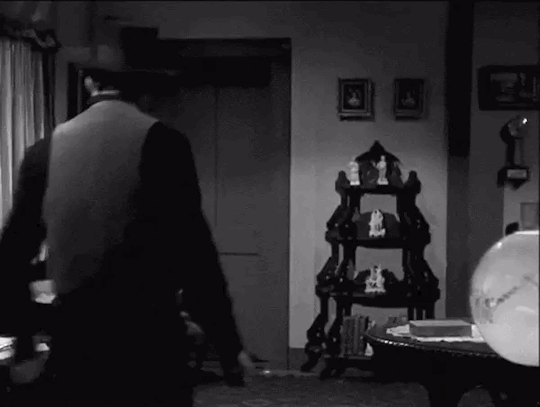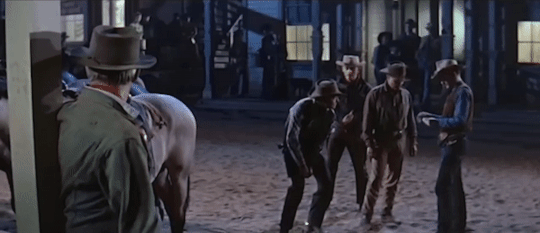#the western warlock
Explore tagged Tumblr posts
Text

Something for @comikbook my beloved of their DnD character in the supernatural western I DM for 💜💜
#dnd oc#dnd5e#dnd character#dnd art#dnd#dnd ocs#dnd campaign#dnd homebrew#western#cowboy#vampire aesthetic#vampire oc#fanart#dungeons and dragons art#digital artist#oc art#digital art#original art#art#cowboy oc#warlock
631 notes
·
View notes
Text






i’m so incredibly normal about him y’know
#deforest kelley#gifs#my gifs#warlock#warlock 1959#old west#western#western film#curley#curley warlock#mine
269 notes
·
View notes
Text


Unfinished sketchbook page
101 notes
·
View notes
Text
Since it's Deforest Kellys birthday, and i have recently been trying to consume all his cowboy content possible, have my review(literally just photos) on one of my favorite cowboy movies that he's in so far:

De plays a rambunctious cowboy named Curley Burne, an absolutely silly(My opinion) gang member.
His first appearance:

(he's being a menace and running the sheriff out of town)
First named appearance:


He's still has a good standing with some of the townspeople but they still hate the gang.
His first interaction with the Marshall:



I swear, he's so silly
Up to his shenanigans:

His posture is so snazzy:

He's so very smug
When he starts to show his true colors (green):

He's a good old friend
And of course, the clips:
I love all his whistling and he's so sarcastic! All in all i think he's great.
55 notes
·
View notes
Text
*Pulls up a bar stool next to you*
So, DeForest Kelley was a genius casting choice for Warlock’s Curley Burne. Why? Ok, listen.
According to the book, Abe, the head cowboy, is a sentient pile of festering cowpies. He’s canonically a cattle thief/dog abuser/serial killer who still manages to make literally everything revolve around his “everyone hates me” victim narrative. He’s beyond tiresome. He has no redeeming qualities other than owning a ranch in the middle of nowhere.
Who can stand a person like that for more than 30 seconds? You know who. A person saddled (ha) with an overactive empathy gland. Who can’t stand to see his brother in pain. Who will work double or triple OT in emotional labor to try to prevent that. Curley is a criminal, yes, but he has a heart of gold. In the book, it’s oversized enough that he sacrifices himself just for his BFF’s honor.
In short, he is the perfect bridge between De’s 50s western villains and Dr. McCoy and TYSM for coming to my drunken TED Talk.
#deforest kelley#western!de#meta#sorry guys#i know ive been mia forever#have had a rough year for reasons#curley thoughts help so much tho#have missed this fandom and hope everyone is well#warlock
27 notes
·
View notes
Text

Yee to the haw
#my art#art#digital art#illustration#character design#dnd#cowboy#western#tiefling#gunslinger#warlock
52 notes
·
View notes
Text




designed even more dnd characters for a western campaign :3 jed and beau are mine
#dnd#dnd oc#dnd character#dnd art#dungeons and dragons#dungeons and dragons character#dnd western#dnd cowboy#western#cowboy#art#my art#digital art#warlock
37 notes
·
View notes
Video
tumblr
ilovejhim ilvehjim
ac 1d9a7n6 (ig)
#western!de#deforest kelley#warlock 1959#curley burne owns my soul help#his hips sway violently im sobbnig
71 notes
·
View notes
Note
Terra: sheriff I got tickets to this magic show coming up of someone named trixie (**oblivious at the time Trixie is his daughter**) Drive and a friend of mine couldn't go would you and your wife like them? I'll be watching the show too.


Splunge: Thanks for the ask, @anideterm3! :3
17 notes
·
View notes
Note

I wish to hear about the Western AU please.
Extra info not on the ref:
They were kicked out at 18 for being gay and worked at a coffee shop until they moved to the spooky month town at 21. She’s one of Eyes’ kids and has powers b/c of it. Lesbian.
(there’s also Petunia and Cassia but I wanted to hear about Alice first)
I’m assuming you want me to put them into the western AU!!
Ok so she’s absolutely a high mage- but refuses to use their powers!
Because they were raised rich- and such, they were raised to use magic. But also because she’s a child of eyes she may be more of a witch than a mage- or a warlock actually- I dunno, magic! She works at the general store, alongside Kevin! And is always sparred when the cult performs their monthly assaults on the town-
60 notes
·
View notes
Text



S4 E5 — Chapel negotiates a truce with the help of McCoy's family recipe. Curley demonstrates his excellent lettering and spelling. Spock discovers the solution to a circuit burnout is a firm slap to Toby Jack's face. Check out the full cowboy crossover series in case you missed an entry!
#star trek#leonard mccoy#mr spock#jim kirk#deforest kelley#leonard nimoy#william shatner#western!de#warlock#apache uprising#catlow#curley burne#toby jack saunders#photo edit#cowboy crossover#star trek the original series
169 notes
·
View notes
Text
Just these couple more curleys of course..









11 notes
·
View notes
Text






I commented something the other day about those little thigh-tie strings for gun belts, and it ended up kicking off a week-long hyperfixation which I’ve decided to commemorate.
SO, here are some highlights of western!De’s thighs wearing the little cowboy garter belt. Please enjoy. 🤠 (There are probably others; please feel free to add if you’re as normal about this as I am.)
#also#i didn’t realize this being a city slicker but#apparently real cowboys didn’t really use the thigh strap?#and this was more of a Hollywoodism to help actors not drop their guns as much?#idk#the more you learn ig#l to r top to bottom#star trek tos#tension at table rock#mackenzie’s raiders#lawman#black spurs#warlock#deforest kelley#dk gifsets#western!de#cw guns
127 notes
·
View notes
Text

Fandom Problem #5969:
When are western companies gonna stop being cowards and give us canon mlm in cartoons? The whole "wlw is safer" excuse is such bs. Homophobes aren't more accepting just cause they're women. It's 2022 dammit, give me dudes who've been together for thousands of years, warlocks who are rivals to lovers, an earthbender who ends up with his best friend, an underground rebel who falls for the sheltered rich guy. There are so many possibilities and yet...
54 notes
·
View notes
Text


dnd song aesthetics: Lafayette, Orville Peck; requested by anon, #12
Last born son, yeah, loaded gun
In a fantasy western setting, McCoy is a warlock with a jackalope familiar and hiding a curse. He won't tell his party, of course- they're too busy with the biggest train robbery of their lives. It's not a big deal. All he has to do is never fall in love, and his patron (the great fiend Lafayette) will never activate the curse. And where, in this wild west filled with monsters and magic, would love happen? After all, McCoy's got a loaded gun and a curse for a heart.
#dungeons and dragons#dndedit#character aesthetics#orville peck#me: no these aren't aesthetics for the musicians just the songs#also me: this is orville peck as a warlock
48 notes
·
View notes
Text
Introduction to my Fantasy Princess dr
✧⋄⋆⋅⋆⋄✧⋄⋆⋅⋆⋄✧✧⋄⋆⋅⋆⋄✧⋄⋆⋅⋆⋄✧✧⋄⋆⋅⋆⋄✧⋄⋆⋅⋆⋄✧✧⋄⋆⋅⋆⋄✧⋄⋆⋅⋆⋄✧✧⋄⋆⋅⋆⋄✧⋄⋆⋅⋆⋄✧⋄⋆⋅⋆⋄✧

✧⋄⋆⋅⋆⋄✧⋄⋆⋅⋆⋄✧✧⋄⋆⋅⋆⋄✧⋄⋆⋅⋆⋄✧✧⋄⋆⋅⋆⋄✧⋄⋆⋅⋆⋄✧✧⋄⋆⋅⋆⋄✧⋄⋆⋅⋆⋄✧✧⋄⋆⋅⋆⋄✧⋄⋆⋅⋆⋄✧⋄⋆⋅⋆⋄✧
my face claim; Sofia Wylie as Agatha of the Woods Beyond



Full title; Atlas Éstela Rivera-Aguelle, Crown Heir of Ivorid, current Archmage of the kingdom
about me;
✧. ┊ gifted warlock, under the patronage of the Goddess Iderine (the Ivoridian goddess of magic and the dawn)
✧. ┊ oldest child out of three (two younger siblings who are twins, Circe and Perseus), therefore heir to the throne || i'm NOT slacking off my duties as heir, Percy will be taking up those responsibilities instead in my stead
✧. ┊ born in Xadia, the capital of Ivorid
✧. ┊ age; twenty-three turning twenty four
✧. ┊ pronouns; they/them
✧. ┊ and i'm half elf on my mother's side, my father is fully human
my parents, Queen Eileen Aguelle née Rivera and Prince Consort Adrián Wyriswoth


✧⋄⋆⋅⋆⋄✧⋄⋆⋅⋆⋄✧✧⋄⋆⋅⋆⋄✧⋄⋆⋅⋆⋄✧✧⋄⋆⋅⋆⋄✧⋄⋆⋅⋆⋄✧✧⋄⋆⋅⋆⋄✧⋄⋆⋅⋆⋄✧✧⋄⋆⋅⋆⋄✧⋄⋆⋅⋆⋄✧⋄⋆⋅⋆⋄✧
My friends and allies:
✧. ┊Sol Gomez, my Lady-in-Waiting || secretly a Knight of my personal guard || would technically be classified as a tiefling || twenty-three years old



✧. ┊Mirio Togata, my personal guard || a nephilim || twenty-four years old || knighted by my mother when he was eighteen



✧. ┊Leónidas Aradian of Raimor || True King of The Labyrinth Empire || Vampire || Twenty-two years old



✧⋄⋆⋅⋆⋄✧⋄⋆⋅⋆⋄✧✧⋄⋆⋅⋆⋄✧⋄⋆⋅⋆⋄✧✧⋄⋆⋅⋆⋄✧⋄⋆⋅⋆⋄✧✧⋄⋆⋅⋆⋄✧⋄⋆⋅⋆⋄✧✧⋄⋆⋅⋆⋄✧⋄⋆⋅⋆⋄✧⋄⋆⋅⋆⋄✧



Full Title; Aleksander Jude Ravenson, Crown Prince of Edessa, Rightful King of the Western Kingdom
about him;
✧. ┊ a shadow summoner, a gift inherited from his father's side
✧. ┊ the only child
✧. ┊ born in Eleyver, capital of Edessa
✧. ┊ age; twenty-six turning twenty-seven
✧. ┊ pronouns; he/him
✧. ┊ a dragon-shifter, from his mother's side
some backstory between us;
Aleksander and I had initially met when we were young, he was eleven and I was eight. It was at one of those “debut” balls, just announcing who we were to the kingdom. Right, so, we didn’t exactly grow up together perse, but we were aware of each other, seeing as we were neighboring kingdoms and allies as well. Thing is, there’s this guy from the Certhrian empire that is like hellbent on creating as much discord as possible between all the kingdoms of Xarias and so, my parents, along with his parents, decided to arrange a marriage between Aleks and I to insure that nothing would be able to get between the alliance of our kingdoms.
So we ARE married now
literally us actually can confirm
✧⋄⋆⋅⋆⋄✧⋄⋆⋅⋆⋄✧✧⋄⋆⋅⋆⋄✧⋄⋆⋅⋆⋄✧✧⋄⋆⋅⋆⋄✧⋄⋆⋅⋆⋄✧✧⋄⋆⋅⋆⋄✧⋄⋆⋅⋆⋄✧✧⋄⋆⋅⋆⋄✧⋄⋆⋅⋆⋄✧⋄⋆⋅⋆⋄✧
#Fantasy dr#princess dr#shifting#reality shifting#shifters#shifting antis dni#shifting blog#shifting community#shifting motivation#shifting realities#reality shifter
24 notes
·
View notes